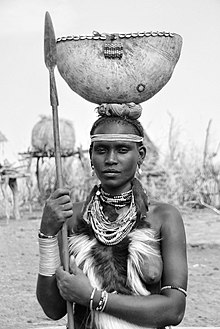Daasanach people
 A Daasanach woman | |
| Total population | |
|---|---|
| Regions with significant populations | |
| Ethiopia, Kenya | |
| Languages | |
| Religion | |
| Traditional African religions and Christianity | |
| Related ethnic groups | |
| Nilotic peoples,[3][a] Aroid (South Omotic) peoples such as the Karo,[3] and Cushitic peoples (primarily of the Western Omo–Tana branch)[4] |
The Daasanach (also known as the Marille or Geleba) are an ethnic group inhabiting parts of

History
The Daasanach are also called Marille especially by their neighbours, the
Language
The Daasanach today speak the
Genetics
Population genetic analyses of the Daasanach indicate that they are more closely related to Nilo-Saharan populations than they are to most Cushitic and Semitic Afro-Asiatic-speaking populations of Ethiopia. This suggests that the Daasanach were originally Nilo-Saharan speakers, sharing common origins with the Pokot. In the 19th century, the Nilotic ancestors of these two populations are believed to have begun separate migrations, with one group heading southwards into the African Great Lakes region and the other group settling in southern Ethiopia. There, the early Daasanach Nilotes would have come into contact with a Cushitic-speaking population, and eventually adopted this group's Afro-Asiatic language.[4]
A 2021 study comparing a variety of Ethiopian populations discovered that the Daasanach people cluster closer to the Nilotic Nyangatom and the Aroid (South Omotic) Karo peoples than they do to most other Cushitic populations of Ethiopia.[3]
Daily life

The Daasanach are a primarily agropastoral people; they grow sorghum, maize, pumpkins and beans when the Omo river and its delta floods. Otherwise the Daasanach rely on their goats and cattle which give them milk, and are slaughtered in the dry season for meat and hides. Sorghum is cooked with water into a porridge eaten with a stew. Corn is usually roasted, and sorghum is fermented into beer. The Daasanach who herd cattle live in dome-shaped houses made from a frame of branches, covered with hides and woven boxes (which are used to carry possessions on donkeys when the Daasanach migrate). The huts have a hearth, with mats covering the floor used for sleeping. The Dies, or lower class, are people who have lost their cattle and their way of living. They live on the shores of Lake Turkana hunting crocodiles and fishing. Although their status is low because of their lack of cattle, the Dies help the herders with
Women are
Media coverage
There are a number of variant spellings of Daasanach, including Dasenach and Dassanech (the latter used in an episode about them in the TV series
See also
Notes
- ^ The Daasanach along with the related Arbore form a branch with the Nyangatom (Teso-Turkanic) and the Karo (South Omotic) on the cladogram (a diagram used in cladistics) showing affinities between a wide sample of Ethiopian populations. See Supplementary Materials of López et al (2021), page 49."Evidence of the interplay of genetics and culture in Ethiopia". Retrieved 2024-04-09.
Further reading
- Uri Almagor, "Institutionalizing a fringe periphery: Dassanetch-Amhara relations", pp. 96–115 in The Southern Marches of Imperial Ethiopia (ed. Donald L. Donham and Wendy James), Oxford: James Currey, 2002.
- Claudia J. Carr, Pastoralism in Crisis: the Dassanetch of Southwest Ethiopia. University of Chicago. 1977.
References
- ^ a b "Census 2007" Archived February 14, 2012, at the Wayback Machine, first draft, Table 5. A further 1,469 are recorded as being "Murle".
- ^ "2019 Kenya Population and Housing Census Volume IV: Distribution of Population by Socio-Economic Characteristics" (PDF). Kenya National Bureau of Statistics. Retrieved 2 May 2021.
- ^ PMID 34117245.
- ^ S2CID 2488794.
- ^ Raymond G. Gordon Jr., ed. 2005. Ethnologue: Languages of the World. 15th edition. Dallas: Summer Institute of Linguistics. Ethnologue entry for Daasanach

